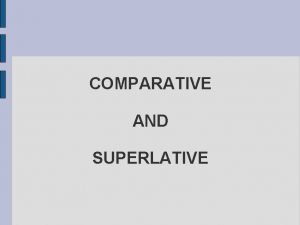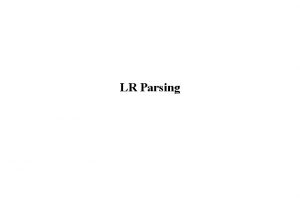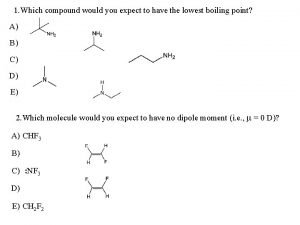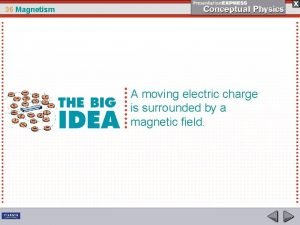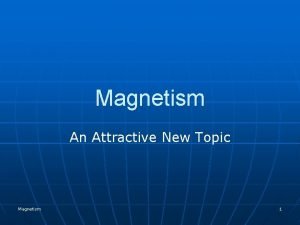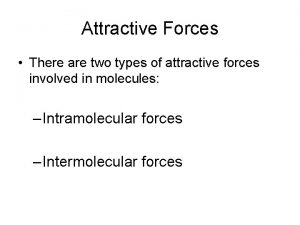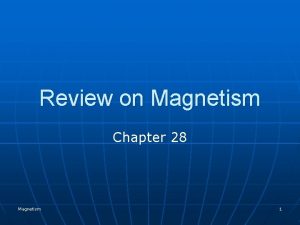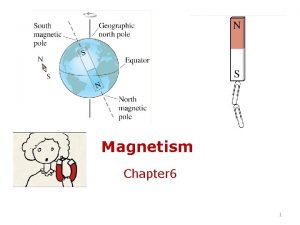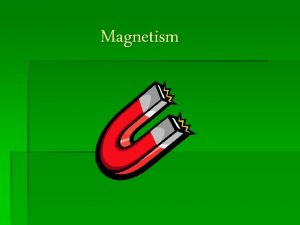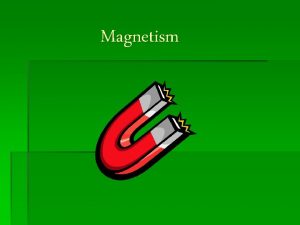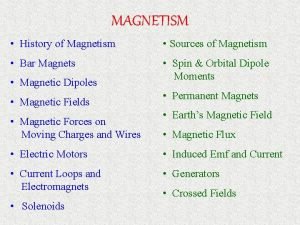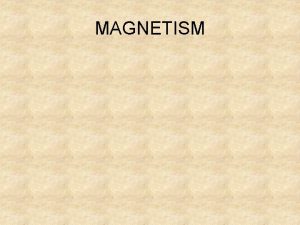Chapter 17 Magnetism What is Magnetism Causes attractive

















- Slides: 17

Chapter 17 Magnetism

What is Magnetism? Causes attractive and repulsive forces n Magnetic properties are due to the motion of electrons n

Properties of Magnets n n A permanent magnet is a material that keeps its magnetic properties. If a material is magnetic, it has the ability to exert forces on magnets or other magnetic materials nearby.

Properties of Magnets n n All magnets have two opposite magnetic poles, called the north pole and south pole. If a magnet is cut in half, each half will have its own north and south poles.

Problem Solving Scenario… Dear Scientist, I own a jewelry store and recently I have made a lot of money using magnets to make earrings, necklaces, and even bracelets. Unfortunately, I only have one big magnet left, but I need to make 3 different pieces of magnetic jewelry. Since I only make money if my jewelry is magnetic, I was wondering if breaking the big magnet into smaller pieces will damage the magnet and make it non-magnetic, or if breaking the big magnet will actually make a few smaller magnets. Please respond as soon as possible! Thanks, Julie Magnets

Properties of Magnets n Magnetic forces can pass through many materials with no apparent decrease in strength.

Magnetic Field Lines n The force points away from the north pole and towards the south pole.

Magnetic Fields n The force from a magnet gets weaker as it gets farther away.

Magnetic Field Lines n n A compass needle is a magnet that is free to spin. A compass needle aligns with the local magnetic field

Earth’s Magnetism n n Studies of earthquake waves reveal that the Earth’s core is made of hot, dense molten metals. Huge electric currents flowing in the molten iron produce the Earth’s magnetic field. https: //www. youtube. com/watch? v=Rv 7 z. T 953290&authuser=0

Check In! n In your notebook, answer the following questions: 1. Magnets have _____ & _____ poles n 2. Magnetic force is due to the movement of _______ in an atom n 3. The force of a magnet gets _______ (stronger or weaker) as you move farther away n 4. Earth’s magnetic field comes from ______ in its core n

Geographic & Magnetic Poles n Earth’s geographic North Pole is actually a south magnetic pole A compass needle’s “north” end is actually attracted to Earth’s “south” magnetic pole!

Declination and “True North” Earth’s geographic north pole and magnetic south pole are not located at the exact same place, so a compass will not point directly to the geographic north pole. magnetic declination: the difference between the direction a compass points and the direction of the geographic north pole

Declination and “True North” n n Magnetic declination is measured in degrees and is indicated on topographical maps. Most good compasses contain an adjustable ring with a degree scale used to compensate for declination.

Magnetic Declination NOW n 0° 16' E ± 0° 24' changing by 0° 4' W per year n http: //www. ngdc. noaa. gov/geomag-web/#declination

Earth’s Magnetism n Earth’s magnetic field is losing approximately 7 percent of its strength every 100 years. n If this trend continues, the magnetic poles will reverse sometime in the next 2, 000 years. https: //www. youtube. com/watch? v=XXTEWQdu 3 a. E&authuser=0

Quick Recap n North and South poles attract (come together) n North-North or South-South repel (push apart) Magnetism is due to moving electrons n Compasses have a north pole magnet (red) n n Attracts to magnetic south (which is north pole)
 Proximate causation vs ultimate causation
Proximate causation vs ultimate causation Proximate and ultimate behavior examples
Proximate and ultimate behavior examples Intermolecular forces in water
Intermolecular forces in water Attractive market segments
Attractive market segments Seven domains of attractive opportunities
Seven domains of attractive opportunities Mullins seven domains model
Mullins seven domains model Attractive meaning
Attractive meaning Attractive sce
Attractive sce Attractive force
Attractive force Well comparative and superlative
Well comparative and superlative Seven domains of attractive opportunities
Seven domains of attractive opportunities The most powerful parser is
The most powerful parser is Intermolecular forces
Intermolecular forces No lewis structure
No lewis structure Attractive forces
Attractive forces Chapter 24 magnetism magnetic fundamentals answers
Chapter 24 magnetism magnetic fundamentals answers Magnetism
Magnetism Physics 102 electricity and magnetism
Physics 102 electricity and magnetism









